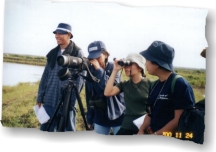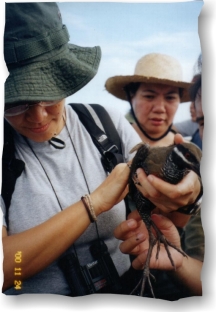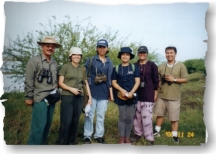![]() back to home
back to home
birdwatching
101
how my first trip made my enthusiasm for conservation
take flight
 Trudging
stealthily on a marshland trail, struggling to keep alert despite it being 5:30 in the
morning. With binoculars slung over my neck and a species list on hand, I tried to make as
little noise as possible. Is this an episode from National Geographic or a feature on the
Discovery Channel? No, but that’s what I felt like on my first bird-watching trip. Trudging
stealthily on a marshland trail, struggling to keep alert despite it being 5:30 in the
morning. With binoculars slung over my neck and a species list on hand, I tried to make as
little noise as possible. Is this an episode from National Geographic or a feature on the
Discovery Channel? No, but that’s what I felt like on my first bird-watching trip.It was in November, last year (2000) when I surprisingly was able to coerce
two of my friends to pry ourselves out of bed at 3 in the morning to drive down to the
Haribon center. All we knew to prepare for the trip was to wear dark clothing, bring a
hat, some food and to We got to our destination the Candaba Marsh at dawn, and even before getting off our van, they told us to spot Egrets flying over and into the distance. How majestic they looked! Enormous wing span and quite easy to spot due to their size and number It was right about there when I was handed a checklist of the different species of birds we could spot there. My eyes widened as I counted 92 listed there! And I was only expecting maybe 2 or 3 species! I couldn’t believe that we had so many different kinds of birds here in the country! It was also of major interest to me that as one scientist noted – the Philippines has 80 or so endemic species whereas countries like the UK had none. All the more curious I was to find out how many I’d be able to spot at the end of the day. My excitement mounted as our scientists Blas Tabaranza and Tim
Fisher pointed out to us the lone Purple Heron sitting high atop a sparsely leafed tree,
the many Black Winged Stilts, easily identified by their long bright red spindly legs and
the daintily colored Blue-Tailed Bee-eater. I was pleasantly educated that even the
Chestnut Munia or "Maya" was not the Maya I thought to be. Its head was black Whereas before I saluted Haribon’s conservation efforts only in theory, to be alongside them was a concrete expression – one that further strengthened my resolve to support the projects and one that I hope would be followed up with many more wonderfully mind-broadening adventures! |
 pay the joining fee. There I
met some 20 or so individuals, scientists, bird-watching enthusiasts from here and abroad,
and regular clueless folks like me.
pay the joining fee. There I
met some 20 or so individuals, scientists, bird-watching enthusiasts from here and abroad,
and regular clueless folks like me.  and body brown. All in all I
was able to jot down 19 kinds of birds that day. I’m quite sure that wasn’t all
there were that day since the I wasn’t able to quickly spot everything pointed out to
us.
and body brown. All in all I
was able to jot down 19 kinds of birds that day. I’m quite sure that wasn’t all
there were that day since the I wasn’t able to quickly spot everything pointed out to
us.